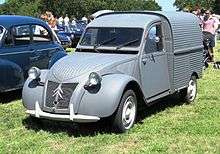PSA Vigo Plant
Coordinates: 42°12′21″N 8°44′37″W / 42.20583°N 8.74361°W
The PSA Vigo plant (Centro de Vigo de PSA Peugeot Citroën) is a Spanish car manufacturing and assembly plant owned by the French car company PSA Peugeot Citroën.
In April 1958 Citroën, responding to the high tariff barriers that protected Spain's domestic auto-makers, established the Vigo car plant[1] in Galicia.[2] As of 2011 the Vigo car plant is one of the largest employers in the region, with 9,700 on the payroll in 2007. It's the company's largest plant outside France with mostly outsourced employments.
Beginnings


The plant's origins go back to the establishment at Vigo in April 1958 of "Citroën Hispania", employing, during that first year, approximately 100 people. The choice of Vigo arose from the presence of the port and from the tax advantages arising from the existence of a government created "freeport" zone. The first vehicle produced was the Furgoneta AZU, a locally assembled small 2CV van, which would be joined at the plant a year later by the passenger car version of the same vehicle.[3] During the first year 400 were produced.
In August 1959 saw a move to the nearby district of Balaídos. The factory's second year was a time of steady expansion, and production rose to 1,700 vehicles, reflecting the increasing pace of apparently economic growth in Spain. Production was focused on the domestic market due to poverty and because of the high mutual tariffs characteristic of Spain's economic relations with its neighbours. By 1960 production was up to 3,600 vehicles and there were more than 500 employees. A decade after the creation of "Citroën Hispania", the factory site had virtually reached its current size.
Life became more difficult in the later 1960s and 1970s. The pace of economic growth became less frenetic and other automakers established a presence in Spain including Ford, who arrived with deep pockets and negotiated a deal with the government which from the beginning permitted (and, if their project were to succeed financially, required) capital intensive high volume low cost production methods for their Fiesta model.
Vigo continued to produce only the 2CV and its derivatives, small cars and vans, until 1971 when the mid-size (and by Spanish passenger car standards of the 1960s, "large") Citroën GS was added to the range. Nevertheless, the ongoing focus on inexpensive economy diesel cars and vans reduced the vulnerability of the business to slumps in demand for larger cars that would follow when the economy faltered during the 1970s.
The Oil Price shock of 1973 hit the automobile industry particularly hard, and in the case of Spain was followed in 1975 by the death of The Dictator, and a period of threatening socio-economic disruption and unrest as the ensuing régime change unfolded. Citroen's Vigo business nevertheless maintained unspectacular but steady growth, with a record output of more than 110,000 vehicles in 1975, by which time the plant was employing more than 6,000 people.
After Peugeot bought Citroën, the Peugeot 504 began production in Vigo in 1977. Later the Peugeot 505 was built at the plant. However, the bulk of production were Citroën cars such as the Citroën Visa, Citroën BX, Citroën AX, Citroën ZX, Citroën Xsara, Citroën Xsara Picasso and Citroën C4 Picasso.
Also, over 1.1 million units of the Citroën C15 van were produced from 1984 to 2005. In 1996, the Citroën Berlingo and Peugeot Partner began production.
On 15 July 2008 the plant celebrated its fiftieth anniversary in the presence of Thierry Peugeot and Juan Carlos I of Spain.
The site
The 66-hectare (160-acre) site includes factory units covering panel stamping, welding, painting and assembly.
Production
Models produced include the Grand C4 Picasso since 2006, and C4 Picasso since 2007, Xsara Picasso and Citroën Berlingo / Peugeot Partner. In 2005 Vigo produced 422,950 vehicles as well as 46,410 CKD kits. By 2007, supported by the success of the second generation Citroën Xsara Picasso,[4] the plant reported an output of 547,000, grouped into three production teams.[5]
References
- ↑ Vigo Vigo, PSA Peugeot Citroën, 27 may 2010. Archived 7 March 2012 at the Wayback Machine.
- ↑ PSA renforce son avance dans les utilitaires, L'Argus, 31 janvier 2008, page 55
- ↑ "DESCUBRIR EL CENTRO". PSA Peugeot Citroën. Retrieved 5 December 2015.
- ↑ Christian Streiff conforte l'avenir de son site espagnol de Vigo, Bertrand Gay, Les Echos, 18 janvier 2008.
- ↑ Dossier de presse PSA Berlingo et Partner II, page 10.
